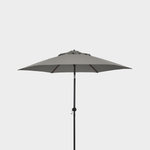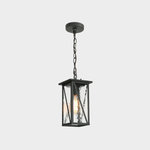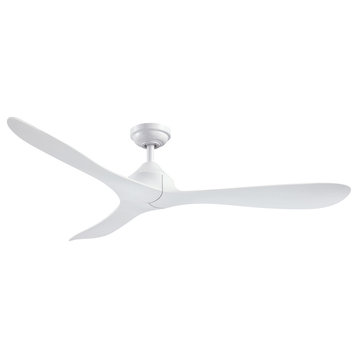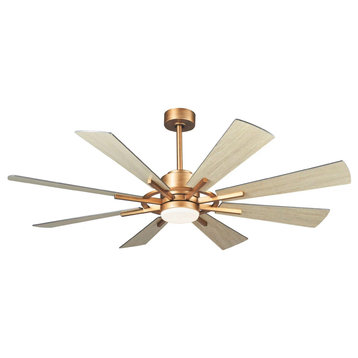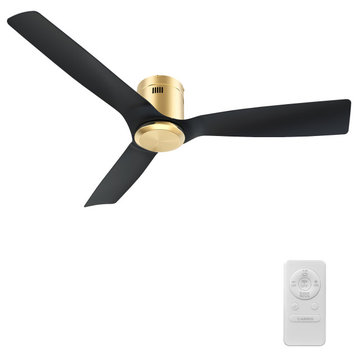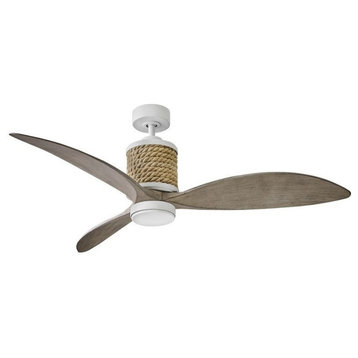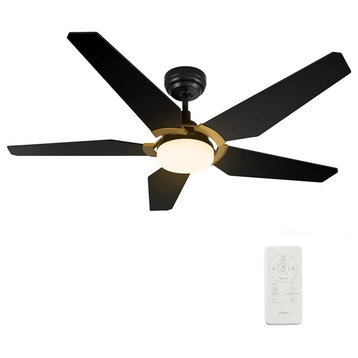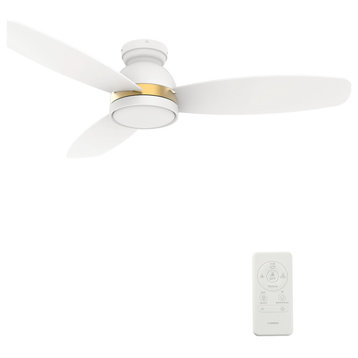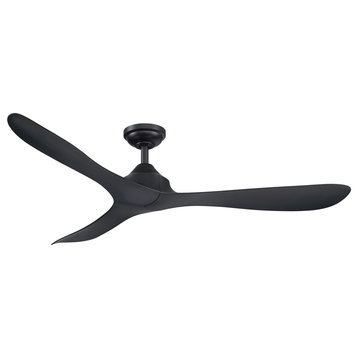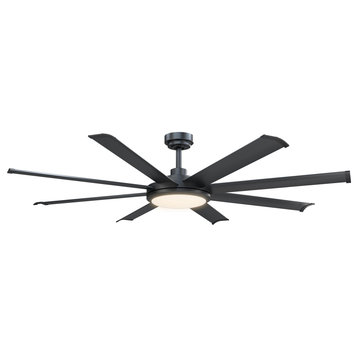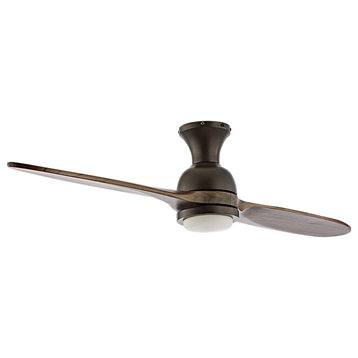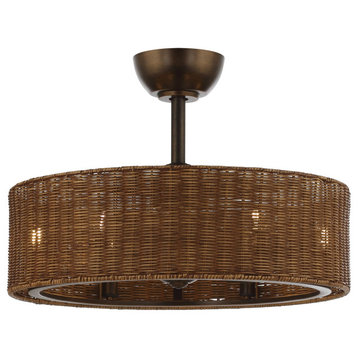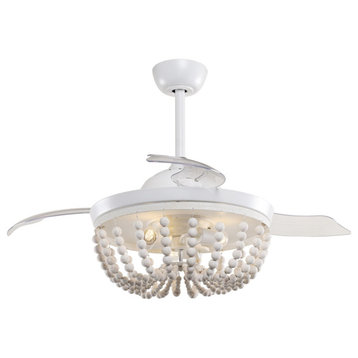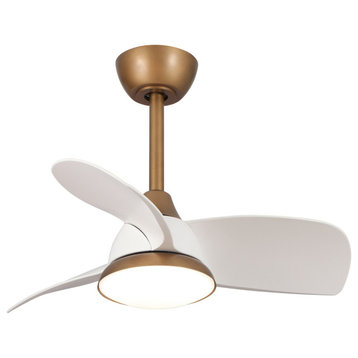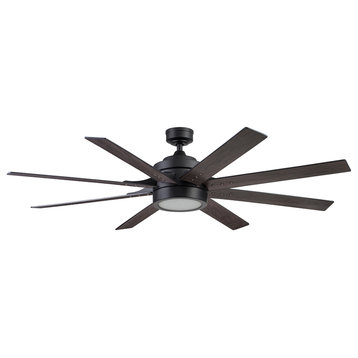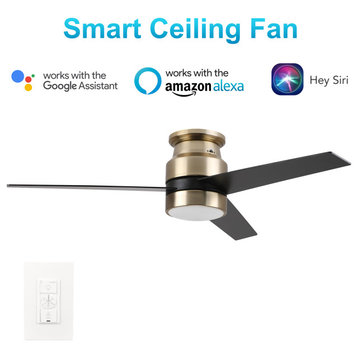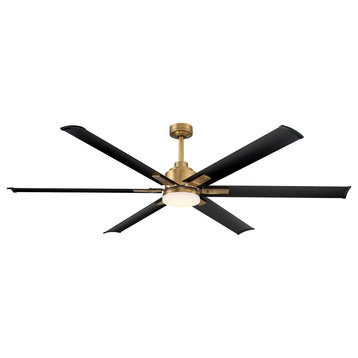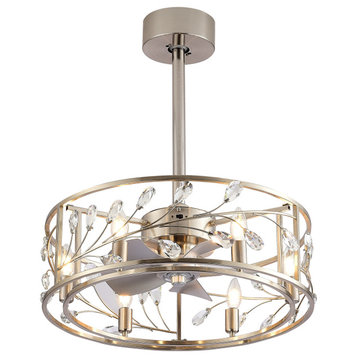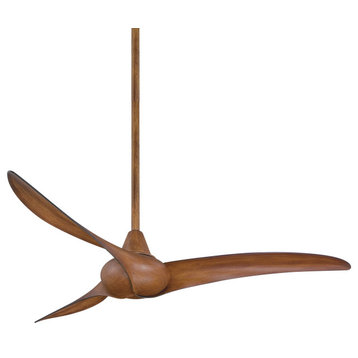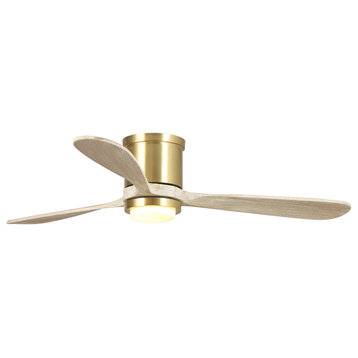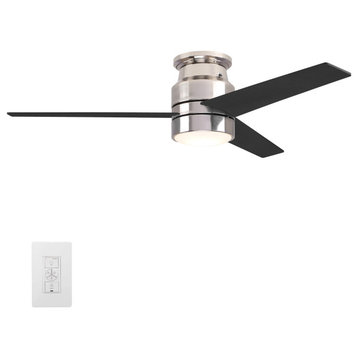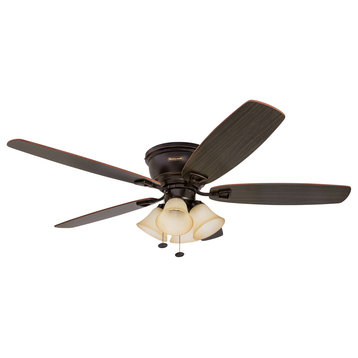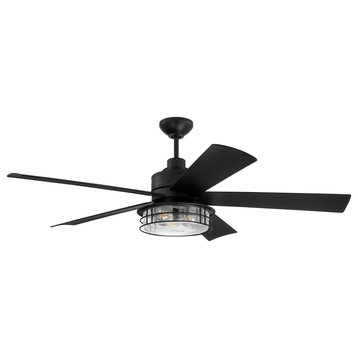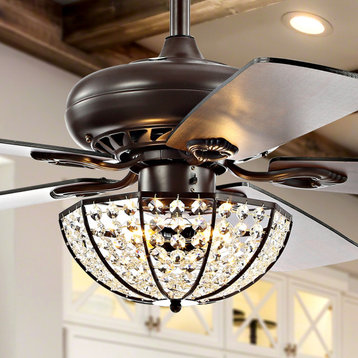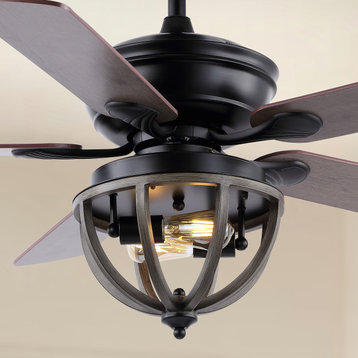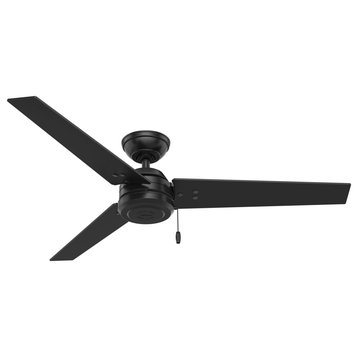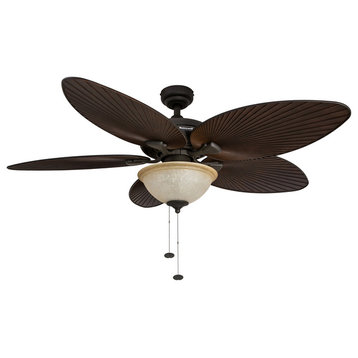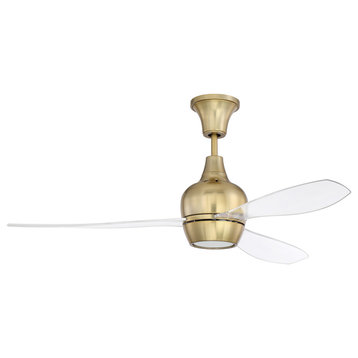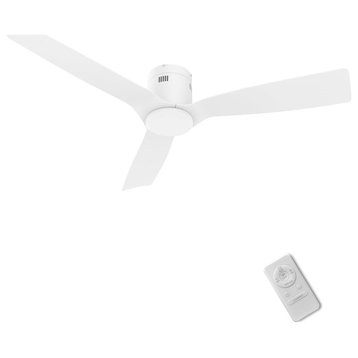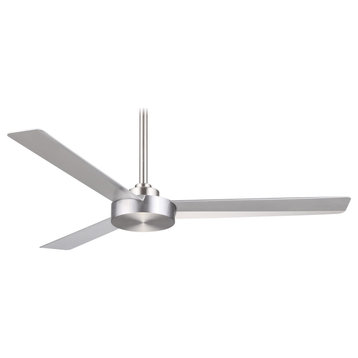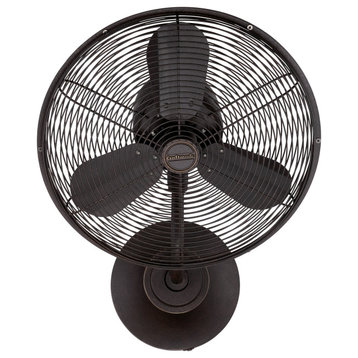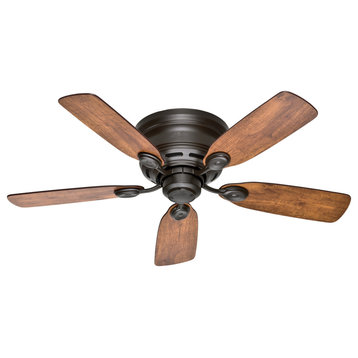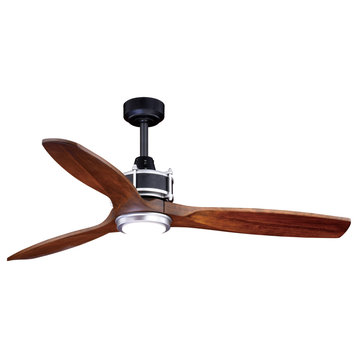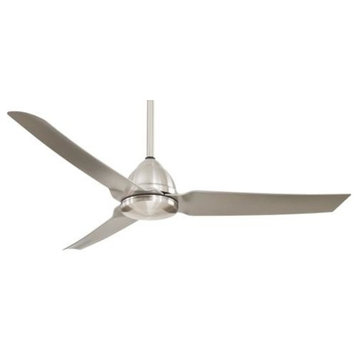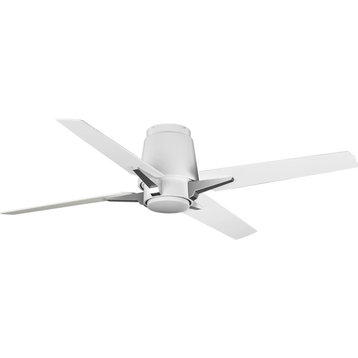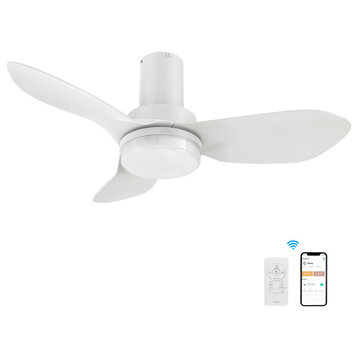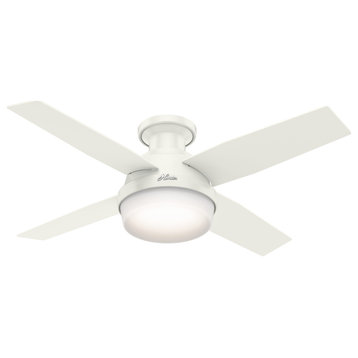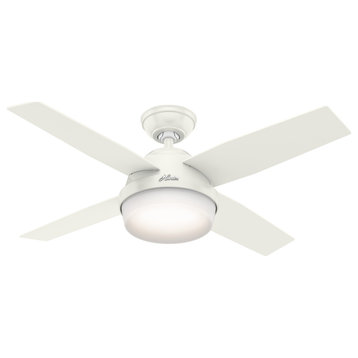FREE shipping on orders over $49!* Details
- All Products
- Lighting
- Ceiling Lighting
- Ceiling Fans
Ceiling Fans
56 in Remote control Modern Ceiling Fan with DC Reversible Motor, Whiteby whoselamp(6)
$165
Free Shipping
Designer Style: Modern 3-blade metal white finish, 4.5 in down rod, suits for most room.
DC Motor: The fan has a reversible DC motor that allows you to change the direction of your fan from downdraft mode during the summer to updraft mode during the winter. This feature helps in maintaining the perfect room temperature throughout the year. It also delivers powerful air movement with quite a performance.
Remote Control: You can keep the fan working with the remote, which provides 6 fan speeds.
Warranty: Offering a limited lifetime motor warranty on all ceiling fans, with a 1-year warranty on all parts, 100% SATISFACTION GUARANTEED
DC Motor: The fan has a reversible DC motor that allows you to change the direction of your fan from downdraft mode during the summer to updraft mode during the winter. This feature helps in maintaining the perfect room temperature throughout the year. It also delivers powerful air movement with quite a performance.
Remote Control: You can keep the fan working with the remote, which provides 6 fan speeds.
Warranty: Offering a limited lifetime motor warranty on all ceiling fans, with a 1-year warranty on all parts, 100% SATISFACTION GUARANTEED
- Number of blades: 3
- Number of speed settings: 6
- Remote control included: Yes
- Battery operated: Yes
- Batteries included: No
- Motor type: DC
- Mounting: Down rod mounted
- Number of rods included: 1
- Rod lengths: 4.5 in
- Overall Size: D: 56 in*H:10.6in
- Canopy Size: D 5.8 in
- Weight: 17.52 lbs
- Maximum airflow speed: 4611 CFM
- Reverse airflow: Yes
- Wall switch operated: No
- Slanted ceiling compatible: Yes
- Maximum angle: 15 degree
- UL listed: Yes
- UL rating: Dry
- Wipe clean with a damp cloth
- Note: Item must be hardwired and professional installation is recommended
60 in. Indoor/Outdoor Windmill 8-Blade Gold Ceiling Fan with Remote and DC Motorby whoselamp(6)
$226
Free Shipping
Featuring a striking windmill silhouette with 8 reversible walnut finish blades, this transitional Fan LED ceiling fan will bring a rustic farmhouse look into your space. And the gold finish provides industrial accenting to this modern handsome design, the energy-efficient LED light is integrated with a white glass shade, meet the daily lighting needs. Easily operate this fan with the included remote control, also a convenient reverse blades direction function.
Features:
- Made from metal, wood, and glass, best combination of the modern and industrial style
- 6-speeds DC motor ensures you find the exact setting for your stimulating comfort
- Integrated 15-Watt LED light included, 3000K warm white color
- Handheld remote control for fan speed and light settings
- Comes with 4 in. and 10 in. downrod included
- Included all mounting hardware, easy to install it
- Supports mounted up to a 15° angle
- Limited lifetime warranty and any replacement parts is available
- Motor power: 40-Watt, hight speed power: 35-Watt
Details:
- Overall Length*Width*Height:60"*60"*13.07"
- Product Weight:8.6KG
- Product Material: copper+iron+aluminum+plywood+glass
- Mounting Type: hanging pipe
- Rod Length: 4 inches/10 inches
- Body Color: Gold
- Number of Blades: 8
- Reversible: Yes
- Blade Material: Plywood
- Blade Color:HT-1055-3PU/MS5036
- Blade Size:3.5*6.2*22.6"
- Number of Lights: 1
- Bulb included: yes
- Bulb Type: LED
- Color Temperature: 3000
- Light Max Power: 15W
- Motor Type:DC
- Motor Power: 40W
- Motor Max Speed: 100RPM
- Control Type: DC
- Fan Speed: 6
- CFM: 6500
- Hight Speed Power: 35W
CARRO 52" 3 Blades Flush Mount Ceiling Fan with Remote Control No Light, Black/Goldby Carro Technology Inc.(4)
$169
Free Shipping
SponsoredThis 52''electric fan keeps your space cooland stylish. It is a soft modern masterpiece perfect for your indoor living spaces. This ceiling fan is a simplicity designing with Gold finish, use very strong ABS blades. The fan features remote control.
Note:Not being required a wall switch.
Note:Not being required a wall switch.
Features
- HIGH-QUALITY MATERIALS: Made with durable and ultra-durable materials.
- POWERFUL DC MOTOR: 10-speed DC motor delivers a strong airflow with energy efficiency. The adjustable settings including reversible airflow options and adjustable speeds.
- REVERSIBLE MOTOR: Downdraft summer mode and updraft winter mode.
- REMOTE CONTROL: Use the multifunctional remote control to control your fan’s settings.
- EASY INSTALLATION: Hassle-free installation with a step-by-step instructions.
- INDOOR USE: Tested for safety. Indoor use only. ETL certified.
- MOUNTING: Secure to flush mount directly on ceiling.
- NOTE: NOT compatible with sloped surfaces.
Specification
- Fan Overall Dimensions: 8.9" H x 52" W x 52" D (No downrod option, Flush mount)
- Product Width: 52”
- Weight:13.5 lb
- Speed Options:10
- Control:Remote Control Only
- Dimmable:No
- Full function remote control - fan speed, light on/off, reverse function
- Material of blades:ABS
- Input power:120 VDC,60 Hz
- Number of Blades:3
- Airflow:5070CFM
- Energy Guide: (All estimate based on typical use, excluding lights).
- Energy Use: 14 Watts.
- Estimated Yearly Energy Cost: $4 (Based on 12 cents per kWh and 6.4 hours use per day. Your cost depends on rate and use.)
Airflow:
- Average 3597 Cubic Feet Per Minute.
- Efficiency: 250 cubic Feet Per Minute Per Watt.
- All estimates are based on typical use, excluding lights.
- Package List
- 10-speed reversible DC motor
- 3 ABS Fan Blades(Acrylonitrile Butadiene Styrene, ultra durable & heat resistant).
- Multifunctional remote control - fan speed, reverse function, and scheduling
- Flush mount, no downrod option
- No light source or LED light kit
- Easy installation with step-by-step instructions
3-Blade Ceiling Fan Weathered Wood Blades and Rope Accents LED Light Kit 60by Bailey Street Home(5)
$478
Free Shipping
3-Blade Ceiling Fan with Weathered Wood Blades and Rope Accents with LED Light Kit 60 inches W x 17.5 inches H-Matte White Finish . Modern meets maritime in the sleek The Budding. Designed with a nautical flair in mind The Budding is available in Matte White with Weathered Wood blades and Metallic Matte Bronze with Walnut blades and features composite blades. The Budding is so versatile; it can be used for both indoor and outdoor spaces.
- Amps: 0.36
- Color Temperature: 3000
- Lumens: 1500
- CRI: 90
- Canopy Included: Yes
- Shade Included: Yes
- Sloped Ceiling Adaptable: Yes
- Canopy Diameter: 6.00
- Rod Length(s): 4.50
- Dimable: Yes
- Assembly Required: Yes
- Canopy Included: Yes
- Sloped Ceiling Adaptable: Yes
- Dimable: Yes
- Shade Included: Yes
CARRO Smart Voice Control Ceiling Fan with Dimmable LED Light and Remote, Black/Gold, 52" Downrodby Carro Technology Inc.(44)
SALE
$178$299
Free Shipping
This 52" smart ceiling fan keeps your space cool, bright, and stylish. It is a soft modern masterpiece perfect for your large indoor living spaces. This Wifi smart ceiling fan is a simple design with a Black finish, uses elegant Plywood blades, Glass shade, and has an integrated 4000K LED daylight. The fan features Remote control, Wi-Fi apps, Siri Shortcut, and Voice control technology (compatible with Amazon Alexa and Google Home Assistant ) to set fan preferences.
- Airflow: 4500CFM; PLY wood blades(5pcs)
- Compatible with Wi-Fi apps and Voice control via Google Assistant, Amazon Alexa, and Siri Shortcut. Function on the remote control - fan speed, fan on/off, light on/off; Forward/Reverse;
- Fans are made with incredibly efficient and completely silent DC motors.
- 10-speed reversible motor allows you to change the direction of your fan from downdraft mode during the summer to updraft mode during the winter;
- Includes integrated 2150Lumens LED light kit(22W) with 3500K (2700K warm light/4000K daylight), it offers lower energy consumption and a longer life span;
- Standard and angled mounting system,1 extension down-rod included (6 in. )
- Coupling cover and canopy cover conceal exposed hardware Easy installation with step-by-step instructions;
- ETL Certified Product;
- For both Indoor and Outdoor use.
CARRO 48" Flush Mount Ceiling Fan With Dimmable LED Light and Remote Controlby Carro Technology Inc.(9)
$198
Free Shipping
SponsoredModern ceiling fan can easily handle a variety of decoration styles, making your home less monotonous and more unique to you.
5 Way to Control: This ceiling fan with remote control can also be controlled by voice, compatible with Alexa, Siri Shortcut, Google Home. For example, "Alexa, adjust the ceiling fan to 5, the yellow light to 70%. 5 ways to control, enjoy the low profile ceiling fan. Use the app to achieve remote control of the ceiling fan no matter where you are. More smart ceiling fan features are available in the APP.
3 Light Colors and Dimmable LED Light: Lights and fans can be controlled separately. This ceiling fan with light has 1915 lumens, 22 watts, dimmable 1% to 100% and 3 color temperature (2700K warm light, 3500K full light, 4000K cool light). According to different scene, use the remote control to adjust the brightness and color temperature of the light that you think are suitable. This ceiling fan with LED light can give you a perfect lighting atmosphere.
Timer Function and Schedule Function: You can make the flush mount ceiling fan turn off automatically after 1/2/3/4/5/6/7/8 hours. In addition, you can also use the schedule function to make your ceiling fan work according to the set time and status. For example, the living room ceiling fan can be set to: Fan: on. yellow light: on. white light: off. time: 17:00. repeat: Everyday. " You can control multiple ceiling fans at once, or set multiple schedules for a single fan.
Reversible DC motor: This modern ceiling fan is equipped with a powerful DC motor that provides ultra-quiet airflow up to 3300CFM. The latest brushless silicon steel DC motor provides extremely quiet performance and has 10 speeds to meet your needs. And the ceiling fan's reverse airflow function allows you to switch the direction from downward to upward, Keeping cool in summer and warm in winter.
5 Way to Control: This ceiling fan with remote control can also be controlled by voice, compatible with Alexa, Siri Shortcut, Google Home. For example, "Alexa, adjust the ceiling fan to 5, the yellow light to 70%. 5 ways to control, enjoy the low profile ceiling fan. Use the app to achieve remote control of the ceiling fan no matter where you are. More smart ceiling fan features are available in the APP.
3 Light Colors and Dimmable LED Light: Lights and fans can be controlled separately. This ceiling fan with light has 1915 lumens, 22 watts, dimmable 1% to 100% and 3 color temperature (2700K warm light, 3500K full light, 4000K cool light). According to different scene, use the remote control to adjust the brightness and color temperature of the light that you think are suitable. This ceiling fan with LED light can give you a perfect lighting atmosphere.
Timer Function and Schedule Function: You can make the flush mount ceiling fan turn off automatically after 1/2/3/4/5/6/7/8 hours. In addition, you can also use the schedule function to make your ceiling fan work according to the set time and status. For example, the living room ceiling fan can be set to: Fan: on. yellow light: on. white light: off. time: 17:00. repeat: Everyday. " You can control multiple ceiling fans at once, or set multiple schedules for a single fan.
Reversible DC motor: This modern ceiling fan is equipped with a powerful DC motor that provides ultra-quiet airflow up to 3300CFM. The latest brushless silicon steel DC motor provides extremely quiet performance and has 10 speeds to meet your needs. And the ceiling fan's reverse airflow function allows you to switch the direction from downward to upward, Keeping cool in summer and warm in winter.
- 3 Color Temperature: 2700K, 3500K, 4000K
- Dimmable LED Light: 1-100%
- Timer: 1-8 hours
- Schedule Function: Yes
- Recommended Room SizeSmall Room (75-144SQ FT)
- 5 way to control: remote control / APP / Alexa / Google Home / Siri Shortcuts
- Recommended Uses For Product:Air Circulation
Package List:
- 10-speed reversible DC Motor
- 3 Plywood Fan blades
- Remote Control
- Flush mount, No downrod option
- Includes integrated LED light kit
56 in Remote control Modern Ceiling Fan with DC Reversible Motor, Blackby whoselamp(6)
$155
Free Shipping
- Designer Style: Modern 3-blade metal black finish, 4.5 in down rod, suits for most room.
- Remote Control: You can keep the fan working with the remote, which provides 6 fan speeds.
- Warranty: Offering a limited lifetime motor warranty on all ceiling fans, with a 1-year warranty on all parts, 100% SATISFACTION GUARANTEED
- Number of blades: 3
- Number of speed settings: 6
- Remote control included: Yes
- Battery operated: Yes
- Batteries included: No
- Motor type: DC
- Mounting: Down rod mounted
- Number of rods included: 1
- Rod lengths: 4.5 in
- Overall Size: D: 56 in*H:10.6in
- Canopy Size: D 5.8 in
- Weight: 17.52 lbs
- Maximum airflow speed: 4611 CFM
- Reverse airflow: Yes
- Wall switch operated: No
- Slanted ceiling compatible: Yes
- Maximum angle: 15 degree
- UL listed: Yes
- UL rating: Dry
- Wipe clean with a damp cloth
- Note: Item must be hardwired and professional installation is recommended
60 in Modern Ceiling fan with 8 Blades, Remote Control in Matte Blackby FLINT GARDEN INC(9)
$234
Free Shipping
Ceiling Fan with Lights: LED bulbs ( included) to provide ample illumination and trim your electric bill.
Ceiling fan with remote: With the remote control, the fan provides 6 fan speeds and delivers powerful air movement with quite a performance.
Ceiling fan with downrod-Mount: Adjustable hanging height, 6 &10 inch downrod included, you can choose the length according to your needs.
Warranty:1-year unlimited warranty, friendly customer service, 100% SATISFACTION GUARANTEED
Ceiling fan with remote: With the remote control, the fan provides 6 fan speeds and delivers powerful air movement with quite a performance.
Ceiling fan with downrod-Mount: Adjustable hanging height, 6 &10 inch downrod included, you can choose the length according to your needs.
Warranty:1-year unlimited warranty, friendly customer service, 100% SATISFACTION GUARANTEED
Features:
- Fixture Finish: Matte Black
- Design: Standard
- Mounting: Downrod-Mount
- Fan Blade Length:700.5 mm
- Fan Blade Width:97.7 mm
- Total Fan Height:329 mm
- Blade to Ceiling Height:259 mm
- Canopy Height: 140 mm
- Canopy Width:140 mm
- Canopy Depth :54 mm
- Downrod Length: 6 inches and 10 inches(2 pcs)
- Style: Modern & Contemporary
- Indoor/Outdoor: Indoor
- Number of Lights:1
- Bulb Type: LED
- Bulb Watt: 24 W
- Color Temperature(CCT) Kelvin: 3000
- Bulb Included:Yes
- Delivered Lumens (lm): 1466
- Lumensper Watt (lm/W): 61.26
- Color Rendering Index (CRI): 83.4
- Light Cap Included(Yes / No): No
- Number of Blades: 8
- Blade Span:60 inches
- UL Rating: Dry
- Slanted ceiling compatible: Yes
- Maximum angle: 15��
- Overall Size: D: 60 in H:13.1 in
- Canopy Size: D 5.5 in
- Weight: 20.2 lbs
- Airflow: 6200 CFM
- Motor Type: DC
- DC Motor(Yes / No):Yes
- Motor Size(mm):156*12 mm
- Length of wire from Motor(inches):21 mm
- Motor Watts(High):35
- RPM:110
- Features: Remote Control
- Remote Included: Yes
- Suggested Room Size: 90-225 sq.ft
52" 2-Blade LED Ceiling Fan With Remote Control and Light Kit, Bronzeby GETLEDEL(22)
$199
Free Shipping
This 52" LED ceiling fan features a mixed charm of retro and modern sense with brushed nickel/bronze finish and walnut/light maple blades. Its powerful motor not only delivers optimal airflow but also provides a breeze-quiet wind which is comfortably cozy. There are 5 speeds that can be adjusted to meet your different needs and maintain the ideal comfort level. The stylish and minimalist design makes this sleek ceiling fan suitable for living rooms, bedrooms, dining rooms and kitchens.
Features:
- Reversible fan direction provides ideal use in both winter and summer
- Integrated LED light offers a cool/warm light through the glass cover
- Fan and light can be controlled individually with the remote
- Adjustable color temperatures: 3000K/4000K/6000K
24 in. Indoor Bronze Gold Farmhouse Rattan Caged Ceiling Fan with Remote Kitby whoselamp(7)
$314
Free Shipping
Look no further for a ceiling fan with lights and style than this 24.2 in. indoor cage fan ideal for a variety of style settings. Light sources glow from within a cottage bronze gold farmhouse rattan shade for an illumination sure to warm any living space. Blades rotate within the cage design to offer a cool downdraft in the summer or a warm updraft in the winter for year-round comfort.
- Operate fan speed and lights can be separately controlled by remote
- Quiet 6-speed reversible DC motor for maximum year-round comfort and savings, strong wind while no noise
- Lamp body is made of iron and decorated with rattan shade, gorgeous and farmhouse style ceiling light fixture
- Support sloped ceiling but maximum slope is 15°
- All mounting hardware and installing guide come included
- Limited lifetime warranty, and replacement resend free
- Fan requires LED 4-Watt x 6, E12 base socket Type B, bulbs not included
- Package includes with 8 in. down rod for mounted
- 6-speeds controller, allowing you to choose the 1 best suit for your comfort
Details:
- Assembled Size (in.): 24.2" * 24.2" * 18.1"
- Downrod Length (in.): 8
- Fan Blade Length (In.): 7" *3.8" - 16.5" Span
- Airflow (CFM): 1735
- Blade Color: Bronze Gold
- Bulb wattage (watts): 24
- Damp/Wet Rating: Dry Rated
- Fan Blade Material: Acrylonitrile Butadiene Styrene (ABS)
- Fixture Color/Finish: Bronze Gold
- Light Bulb Base Code: E12
- Motor Speed (RPM): 720 RPM
- Mounting Type: Downrod Mount
- Number of Blades: 3 Blades
- Number of Lights: 6 Light
- Number of Speeds: 6
- Product Weight (lb.): 20 lb
- Recommended Light Bulb Shape Code: E12
- Recommended Room Size: Small Room
42 in Modern White Ceiling fan with Retractable Bladesby FLINT GARDEN INC(9)
$152
Free Shipping
Ceiling Fan with Lights: 3*E26 bulbs (not included) to provide ample illumination and trim your electric bill.
Ceiling fan with remote: With the remote control, the fan provides 3 fan speeds (Low, Medium, High) and delivers powerful air movement with quite a performance.
Ceiling fan with downrod-Mount: Adjustable hanging height, 4 &10 inch downrod included, you can choose the length according to your needs.
Modern Ceiling Fan: It is a better combination of a ceiling fan and light.
Warranty:1-year unlimited warranty, friendly customer service, 100% SATISFACTION GUARANTEED
Ceiling fan with remote: With the remote control, the fan provides 3 fan speeds (Low, Medium, High) and delivers powerful air movement with quite a performance.
Ceiling fan with downrod-Mount: Adjustable hanging height, 4 &10 inch downrod included, you can choose the length according to your needs.
Modern Ceiling Fan: It is a better combination of a ceiling fan and light.
Warranty:1-year unlimited warranty, friendly customer service, 100% SATISFACTION GUARANTEED
Features:
- Fixture Finish: White
- Design: Standard
- Mounting: Downrod-Mount
- Downrod Length: 4 inches and 10 inches(2 pcs)
- Style: Modern & Contemporary
- Indoor/Outdoor: Indoor
- Number of Lights: 3
- Bulb Base: E26
- Bulb Included: No
- Number of Blades: 3
- Blade Span: 42 inches
- UL Rating: Dry
- Slanted ceiling compatible: Yes
- Maximum angle: 15°
- Overall Size: D: 42 ”*H:18.62”
- Canopy Size: D 5.9”
- Weight: 22 lbs
- Rated Voltage: 110-120 V
- Motor: 153x12mm pure copper motor
- Features: Remote Control
- Remote Included: Yes
- Suggested Room Size: 90-225 sq.ft
28 in. Modern Integrated LED Indoor Ceiling Fan with Remote Control and DC Motorby whoselamp(5)
$107
Free Shipping
This 28 in. antique brass gold finish ceiling fan features with a 6 speed motor, high-performance assures powerful, whisper-quiet operation. Flawlessly implemented the industrial charming, the integrated LED lampshade shallow dome in 18-Watt, light in 3000K, 4000K, 6000K dimmable. 3 spinning blade element availabled in 2 finishes (Black/White), easily controlled by remote, surely a statement piece for your kitchen, dining room, living room, bedroom or foyer.
Features:
- Color Changing Technology,DC Motor,Dimmable,Easy Install,Reversible Motor,Timer
- 6-speed whisperwind DC motor delivers ultra-powerful air movement with whisper-quiet performance so you get the cooling power you want without the noise
- Reversible motor allows you to change the direction of your fan from downdraft mode during the Summer which helps cool the room to updraft mode during the Winter to help circulate trapped warm air near the ceiling
- Handheld remote included for easy fan adjustments from anywhere in the room
- Included light kit lets you control the lighting and ambiance of your living space, the long-lasting LED bulbs have longer lifespan than traditional bulbs
- Fully-dimmable integrated LED light comes included, also support CCT in 3000/4000/6000K 3-light temperatures
- UL rated safty for indoor use only, making it ideal for spaces like living rooms, bedrooms, home offices, and kitchens
- 10 in. downrod assembly included, support sloped ceiling but max 15 degrees
- Motor type in DC, powered in 27-Watt, light maximum power in 18-Watt
- Limited lifetime warranty, any replacement resend free
- Overall Length*Width*Height:28"*28"*10 1/2"
- Product Weight:3.5KG
- Product Material:Iron, ABS
- Mounting Type: Downrod Mounted
- Rod Length:10”
- Body Color: Gold
- Number of Blades:3
- Reversible:Yes
- Blade Material:ABS
- Blade Color:Black
- Blade Size:16.3" * 7"
- Socket Type:LED
- Number of Lights:No
- Bulb included: Yes
- Color Temperature:3000/4000/6000K,dimmable
- Light Max Power:18
- Motor Type:DC
- Motor Power:27
- Motor Max Speed:304
- Control Type:M28C0327Z18
- Fan Speed:6
- CFM:4980
- Hight Speed Power:27
- Energy Efficiency:184.44
Honeywell Xerxes Modern Ceiling Fan With Light and Remote, 62", Matte Blackby Honeywell Ceiling Fans(6120)
SALE
$208$377
Free Shipping
SponsoredHoneywell ceiling fans make your home comfortable in summer (and winter) as well as help to reduce energy costs. Enjoy the welcome breeze in any room of your home while looking stylish.
- This modern multi-position indoor ceiling fan combines stylish details with contemporary influences for a truly inspiring fixture for your home. This large fan features a beautifully frosted glass and LED lighting.
- The innovative 8-blade design provides ultra-efficient, adjustable and energy efficient airflow while the dimmable LED lights provide ideal lighting to fit any mood. Control your Honeywell ceiling fan with a touch of a button with our easy-to-use universal ceiling fan remote control with wall mount option (batteries included).
- Enjoy year-round comfort by adjusting the reversible airflow switch that easily allows you to change the direction of the fan to properly distribute air. During hot summer months it will provide a cooling effect or when reversed, spreading warm air in the winter to help reduce energy costs.
- Specifications: Sizing: 62-in 8-blade indoor fan for rooms over 400 sq. ft. Lighting: 4 inch LED board provides 1400 lumens, 18 watts, 3000k color temperature, dimmable 10% to 100%.
Carro 52'' Indoor Ceiling Fan with Light Wall Control and Remote by Wifi App, Goldenby Carro Technology Inc.(71)
$179
Free Shipping
Ranger Smart Ceiling Fan with an LED light kit cased with white glass and black fan blades. The contemporary and sleek design brings a modern touch to home décor for the living room or the bedroom. One of the most affordable smart fans in the market.
[BUY WITH CONFIDENCE]: We put customers first. A US-based company, friendly tech, and customer support are available.
[BUY WITH CONFIDENCE]: We put customers first. A US-based company, friendly tech, and customer support are available.
Features:
- Compatible with Wi-Fi apps and Voice control via Google Assistant, Amazon Alexa, and Siri Shortcut.
- Function on wall control - fan speed,fan on/off,light on/off;
- Forward/reverse function switch on fan body
- Incredibly efficient & Completely Silent AC motors.
- 3-speed reversible motor: We can change the direction of the fan from downdraft mode during the summer to updraft mode during the winter;
- Includes integrated LED light kit with warm light
- Standard and angled mounting system
- ETL Certified Product
Specifications:
- Model Name: Ranger
- Item Type: Smart Ceiling Fan
- Blade Material: Plywood
- Number of Blades: 3
- Length*Width of Blade Size(in.): 23.2*5.7
- Measures 52 x 52 x 11.6 inch.
- Number of Light Kit:1
- Maximum Wattage(Light Kit):18W
- Integrated LED Color Temperature: 3000K warm light /1062Lumens
- LED Dimmable: No
- Maximum Wattage(Motor):50W
- Motor Speed(RPM): 81/130/182
- Number of Speed:3
- Maximum Airflow(CFM): 3462
- Voltage(V): 120V
- Energy Star Compliant: No
- Multiple Control Options: Wall control, Wi-Fi apps, and Voice control via Google Assistant, Amazon Alexa, and Siri Shortcut.
- Flush Mounted
- Product Weight (lbs): 14.1lb
- Shipping weight (G.W.): 16lb
Package List:
- Variable 3-speed reversible AC motor.
- 3 Fan blades.
- Smart wall switch.
- Includes LED light kit.
- Screw Package.
- Easy-to-follow, step-by-step instructions
[INSTALLATION NOTE]:
REQUIRES NEUTRAL WIRE(white), LIVE WIRE (red or black), BARE or GROUND WIRE(green) and LOAD WIRE(separate two wires, one for light, the other one for fan). Please confirm that the wiring in your home is compatible before purchasing the smart ceiling fan (older house may not have neutral wires). No Hub required. No canopy module required.72 in. Integrated LED Indoor Natural Brass Ceiling Fan with Light and Remoteby whoselamp(6)
$286
Free Shipping
Great for large areas or lofts is this 72 in. Natural Brass ceiling fan, The powerful DC motor can cool a large room and push out 7928 CFM of cooling, It features a full-function 6-speed motor that is 3-times the power of a traditional ceiling fan. The included remote control allows you to control the light, speed function, the dome style light kit with plastic lamp shade includes a 18-Watt LED light source and is set at 3000K temperature (warm white). This fan and lighting kit must be hardwired and installed by a qualified electrician.
Features:
- DC Motor,Easy Install,Reversible Motor,Timer
- Included: Downrod Included,Hardware Included,Light Kit Included,Shade(s) Included,Timer
- 6 weather-resistant black aluminum blades, total span 72 in.
- Dome style light kit included, best combination of ceiling fan and chandelier
- High performance reversible DC motor assures powerful, no noisy
- Threaded down rod, 8 in. L x 3/4 in. Dia for tighter stability
- Uses a 18-Watt Integrated LED module, 3000K LED temperature in warm light
- Energy efficient DC motor with 6 speeds, great for large sized room
- Hand-held remote control operates this fan with independent light and speed control
- Reversible function, keeping you warm in winter and cool in summer
- Comes with the English installation instructions, easy to install
- Limited lifetime warranty, any replacements resend free
Details:
- Airflow (CFM): 7928
- Blade Color: Black
- Ceiling Fan Size: Extra Large
- Ceiling Fan Type: Basic
- Color Family: Brass
- Color Temperature: Warm White
- Compatible Bulb Type: Integrated LED
- Control Type: Remote Included
- Damp/Wet Rating: Dry Rated
- Fan Blade Material: Aluminum
- Fixture Color/Finish: Natural Brass
- Light Bulb Type Included: Integrated LED
- Light Type: Integrated
- Motor Speed (RPM): 300 RPM
- Mounting Type: Downrod Mount
- Number of Blades: 6 Blades
- Number of Lights: 1 Light
- Number of Speeds: 6
- Product Weight (lb.): 26 lb
- Watt Equivalence: 36
Dimensions
- Assembled Depth (in.): 72 in
- Assembled Height (in.): 17.82 in
- Assembled Width (in.): 72 in
- Downrod Length (in.): 8
- Fan Blade Length (In.): 36
- Fan Blade Span (in.): 72
- Fan Blade Width (In.): 5
20" Crystal Caged Chandelier Ceiling Fans with Light Kit and Remote Control, Satin Nickelby Breezary(9)
$166
Free Shipping
Our morden ceiling fan is a combination of ceiling fan and chandelier in a unique style, which features impeccable style and a clean, crisp look. The crystal kit surrounds an energy-efficient Reversible AC fan motor capable of meeting indoor quality air requirements with ease. Inside the crystal kit, it hosts six non-dimmable bulbs to offer a bright illumination. Reversible motor allows you to change the direction of your fan from downdraft mode during the summer which helps cool the room to updraft mode during the winter to help circulate trapped warm air near the ceiling.
Features:
- Style: Contemporary Formal/Glam/Vintage
- Materials: Metal, Crystal
- Color: Satin Nickel
- Number of Blades: 5
- Blade Pitch: 12.5 degree
- Material of Blades:ABS
- Blade color: Sliver
- Bulbs: E12 * 6 (not included)
- Max Buble Wattage:25W
- Angled Ceilings: up to 16 degree
- Motor Type: AC Induction
- Reversible Motor: Yes
- Motor voltage: 110V-120V 60Hz
- Max Motor Speeds: 950
- Max CFM: 1095
Dimensions:
- Installer's Choice three-position mounting system allows for standard, low or angled mounting
- Downrod (short): 4 inches long
- Downrod (long): 10 inches long
- Blade Size:5.27 inches(L)*5.27inches(W)
- Overall Size: 21.6 inches diameter x 21.6 inches height
- Net Weight: 25 lb
Disclaimers & Disclosures:
- Assembly Required
- Unless otherwise noted, this fixture needs to be hardwired. Professional installation is recommended.
Minka Aire Wave 52" Ceiling Fan With Remote Control, Distressed Koaby Minka Aire(1672)
$295
Free Shipping
Features
- Model F843-DK
- Distressed Koa Finish
- Variable Blade Pitch
- 3 Blades 52" Sweep
- Includes 6" Downrods
- Hand Held Wireless Remote Control System
- Factory Authorized Seller; Full Factory Lifetime Warranty
Control Specifications
- Model RCS213
- Includes 1 Hand Held Remote Control and Wall Holster
- Three Speed Fan Control
- On/Off Plus Full Range Light Dimmer
- Operates at Distance of 20-40' Depending on Construction of the Room
- Can be Used in Conjuction with WCS223 Wall AireControl
- 12 Volt Battery Included
- Performance
- RPM (High/Low): 153-61
- Airflow: 6,580 CFM
- Electricity Used: 66.4 Watts
- Airflow Efficiency: 99 CFM/Watts
52 in Modern Flush Mounted Ceiling fan with 3 Blades in Sand Copperby FLINT GARDEN INC(16)
$167
Free Shipping
Ceiling Fan with Lights: LED bulbs ( included) to provide ample illumination and trim your electric bill.
Ceiling fan with remote: With the remote control, the fan provides 3 fan speeds (Low, Medium, High) and delivers powerful air movement with quite a performance.
Modern Ceiling Fan: It is a better combination of a Ceiling fan and light.
Warranty:1-year unlimited warranty, friendly customer service, 100% SATISFACTION GUARANTEED
Ceiling fan with remote: With the remote control, the fan provides 3 fan speeds (Low, Medium, High) and delivers powerful air movement with quite a performance.
Modern Ceiling Fan: It is a better combination of a Ceiling fan and light.
Warranty:1-year unlimited warranty, friendly customer service, 100% SATISFACTION GUARANTEED
Features:
- Fixture Finish:Sand Copper
- Design: Standard
- Mounting:Flushed Mounted
- Style: Modern & Contemporary
- Indoor/Outdoor: Indoor
- Number of Lights: 1
- Bulb Type: LED
- Bulb Included: Yes
- Bulb Wattage: 18 W
- Blade Span: 52 inches
- UL Rating: Dry
- Overall Size: D: 52 *H:10
- Canopy Size: D 7.7
- Weight: 14.33 lbs
- Airflow: 3800 CFM
- Motor Type: AC
- Rated Voltage: 110-120 V
- Rated power(motor): 50 W
- Dimmable: YES
- Color Temperature: 3000/4000/6000 k
- Lumen: 900 LM
- Wire: #1015 18AWG Black, White, Blue
- Features: Remote Control
- Remote Included: Yes
- Suggested Room Size: 90-225 sq.ft
Carro 52'' Indoor Ceiling Fan with Light Wall Control and Remote by Wifi App, Silver&blackby Carro Technology Inc.(71)
SALE
$178$246
Free Shipping
Ranger's 52'' smart ceiling fan works with an AC motor is energy efficient and the integrated LED light kit produces a white light that creates an inviting space. It has a 3 blade that delivers ultra-powerful airflow with whisper-quiet performance, customers will enjoy the cooling without noise. The ceiling fan can change the fan's direction from downdraft mode during the summer to updraft mode during the winter. Carro smart ceiling fan works with Alexa devices, Google Assistant, Siri Shortcut, and Carro Home App. With a simple voice command, users can control the fan from anywhere, anytime: set the fan speed, turn the light on/off, and schedule functions, all directly on the smartphone.
Please confirm that the wiring in your home is compatible before purchasing the smart ceiling fan (older homes may not have neutral wires). No Hub Required. No canopy module is required.
Features:
- Certified Product (ETL).
- Incredibly efficient and completely silent AC motor.
- Compatible with Wi-Fi Apps and Voice control via Google Assistant, Amazon Alexa, and Siri Shortcut.
- Variable 3-speed reversible AC motor
- Smart wall switch changes the fan's direction from downdraft mode during the summer to updraft mode during the winter.
- The integrated LED light kit produces warm soft white and bright cool white.
- Easy to install, reinforced structure design.
Dimensions:
- Motor type: AC motor
- Fan Wattage:50W(Fan);
- Voltage:AC220V/50Hz; 120V / 60Hz
- Light Kit:Warm light(no dim); 3000K; 1062 Lumens
- Size:52”
- Blades(pcs):3
- Material: Plywood (High-Quality)
- Speeds:3
- Airflow:3462 CFM
- Wall Switch: Fan Speed, Light On/Off/Dim, Reverse button on the fan body
- Smart Switch: App control(Wifi); Voice control(Amazon Alexa, Google Assistant, and Siri Shortcut)
- Certification: ETL
Included:
- Variable 3-speed reversible AC motor.
- Fan blades set (3pcs).
- Integrated LED Light Kit.
- Flush-mounting system.
- Screw Package.
- Easy-to-follow, step-by-step instructions.
Please confirm that the wiring in your home is compatible before purchasing the smart ceiling fan (older homes may not have neutral wires). No Hub Required. No canopy module is required.
Honeywell Glen Alden Low Profile Ceiling Fan, 52 Inch, Oil Rubbed Bronze, 4 Lightby Honeywell Ceiling Fan(4216)
SALE
$112$175
Free Shipping
SponsoredThe Honeywell Glen Alden has the perfect balance of style, function, and illumination. This classic ceiling fan features reversible blades, LED lighting, and a reversible motor for year-round comfort.
- CLASSIC / TRADITIONAL: Glen Alden elevates your indoor spaces and adds comfort and light just where you need it.
- LARGE TO MEDIUM SPACES: Having a blade span of 52 inches, this fan is perfect for medium to large rooms such as living rooms, bedrooms, dens and much more!
- DRY-RATED: For indoor use only, install this indoor ceiling fan inside your home to protect its natural beauty and style.
- CEILING FAN WITH LIGHT: This oil rubbed bronze ceiling fan houses four LED bulbs (4 x E26/Medium (Standard)/A15 bulbs included). This LED ceiling fan is 600 lumens, 6.5 watts, 3000k color temperature, and is dimmable 10% to 100%.
- EASY TO USE: Pull Chains included for quick and easy on and off adjustments. This fan is also compatible with universal ceiling fan remote controls (sold separately)
- LOW PROFILE / HUGGER: Hugging the ceiling, this flush mount ceiling fan means more space underneath for furniture, activities, and whatever else makes your house feel like a home.
- DUAL-FINISH REVERSIBLE BLADES: This ceiling fan comes with a different finish on each side of the blades. One side comes in a cimmeron finish, while the other side showcases an ironwood finish. Pick the look that best fits your space!
- QUIET REVERSIBLE MOTOR: This fan comes with a conveniently quiet, 3 speed, reversible motor. The reversible airflow feature allows you to easily change the direction of the fan to properly distribute air- enabling year around comfort: providing a cooling effect in the summer, or when reversed, circulating warm air in the winter.
- QUICK INSTALLATION: Includes "Quick 2 Hang" technology, quickly attach fan blades to the motor housing with ease. Assembling your ceiling fan has never been simpler!
- LIMITED LIFETIME WARRANTY: A Limited Lifetime warranty is offered on this product by the manufacturer.
Craftmade Lighting GAR56FB5 Garrick - 56" Ceiling Fan with Light Kitby Craftmade(82)
SALE
$283$1,227
Free Shipping
The Garrick combines the allure of vintage industrGarrick 56" Ceiling Flat Black Flat Blac *UL: Suitable for wet locations Energy Star Qualified: n/a ADA Certified: n/a *Number of Lights: Lamp: 3-*Wattage:6w E27 bulb(s) *Bulb Included:No *Bulb Type:E27 *Finish Type:Flat Black
Joanna 52" 3-Light LED Ceiling Fan With Remote, Oil Rubbed Bronzeby JONATHAN Y(109)
SALE
$177$648
Free Shipping
Our 52" Oiled Bronze fan combines rustic style and a touch of glam, featuring a domed cage light embellished with crystal drops. Five reversible blades provide plenty of air flow by remote control. Three LED bulbs provide bright, sparkling light.
Features:
- This fan-light combination's crystal accents will dress up a rustic farmhouse living room, bedroom or family room
- Remote control provides 3 different fan speeds
- 5 included reversible blades in a Brown finish matched the Oiled Bronze metal
- Fixture can be adjusted to your desired length
- Eco-friendly 9W bulbs included
- Color: Oil Rubbed Bronze with clear shade
- Body Material: Iron
- Includes: One (1) lamp
- Assembly Required
Dimensions:
- Lamp: 19-24 inches high x 52 inches wide x 52 inches deep
Jasper 52" 2-Light Farmhouse Iron Dome Shade LED Ceiling Fan With Remote, Blackby JONATHAN Y(4)
SALE
$187$594
Free Shipping
Our 52" black ceiling fan is a stylish find, with a simple, modern dome light and Edison-style bulbs. The black finish is complemented by five reversible blades in a rustic greige or brown finish. The handy remote control lets you easily control lighting and air flow.
We see a decorative work of art.
A perfectly curved shade casts a dramatic shadow on a floor. Compatible with LED lightbulbs: as easy on the environment as they are on the eyes. The JONATHAN Y Lighting collection considers every detail from impeccably sourced materials to designer styling. And our prices are so attractive, we've transformed a functional necessity into a fashion accessory.
JONATHAN Y Lighting - a fashion revolution in home decor.
- This fan-light combination is a stylish, low-key addition to your living room, bedroom or family room
- 52" wide with reversible blades to let you choose Ashwood or Coffee Brown
- Includes remote control; professional installation is recommended
- Eco-friendly 4W LED bulb included
- Takes 2 bulbs and compatible with TYPE "A" 40W OR CFL 13W OR LED 4W
- Color Temperature: 2700K
- CRI: 80
- Color: Black
- Body Material: Metal
- Base Material: Iron
- Includes: One (1) lamp
- Assembly Required
- Lamp: 18.50-28.50 inches high x 52 inches wide x 52 inches deep
We see a decorative work of art.
A perfectly curved shade casts a dramatic shadow on a floor. Compatible with LED lightbulbs: as easy on the environment as they are on the eyes. The JONATHAN Y Lighting collection considers every detail from impeccably sourced materials to designer styling. And our prices are so attractive, we've transformed a functional necessity into a fashion accessory.
JONATHAN Y Lighting - a fashion revolution in home decor.
Hunter Fan Company 52" Cassius Matte Black Ceiling Fanby Hunter Fan Company(4861)
SALE
$140$335
Free Shipping
The Cassius is a damp-rated fan, making it perfect for any room in your home or office - including covered porches. This industrial-design fan comes with reversible, 52-inch blades so you can choose a soft wood tone for a gentle appearance or a metallic tone for a consistent, masculine look. The clean lines and exposed motor of this superior performing fan form a no-frills presence creating the perfect accent for your minimalist design style.
- Reversible motor allows you to change the direction of your fan from downdraft mode during the summer which helps cool the room to updraft mode during the winter to help circulate trapped warm air near the ceiling.
- Reversible, 3-speed WhisperWind motor delivers ultra-powerful air movement with whisper-quiet performance so you get the cooling power you want without the noise you don�t
- Installer's Choice three position mounting system allows for standard, low or angled mounting
- Damp rated for use as an indoor or outdoor ceiling fan in spaces exposed to moisture and humidity such as porches, patios, sunrooms, and bathrooms
- Features stainless steel hardware to resist rust
- 13 degree blade pitch optimized to ensure ideal air movement and peak performance
- 3 Matte Black / Grey Walnut Stripe reversible blades included
- Includes 5'' and 3'' downrods to ensure proper distance from the ceiling and optimize air movement at your preferred blade height
- Includes pull chains for quick and easy on/off and speed adjustments
- Limited Lifetime Motor Warranty is backed by the only company with over 130 years in the fan business
- Reversible motor allows you to change the direction of your fan from downdraft mode during the summer which helps cool the room to updraft mode during the winter to help circulate trapped warm air near the ceiling.
- Reversible, 3-speed WhisperWind motor delivers ultra-powerful air movement with whisper-quiet performance so you get the cooling power you want without the noise you don�t
- Installer's Choice three position mounting system allows for standard, low or angled mounting
- Damp rated for use as an indoor or outdoor ceiling fan in spaces exposed to moisture and humidity such as porches, patios, sunrooms, and bathrooms
- Features stainless steel hardware to resist rust
- 13 degree blade pitch optimized to ensure ideal air movement and peak performance
- 3 Matte Black / Grey Walnut Stripe reversible blades included
- Includes 5'' and 3'' downrods to ensure proper distance from the ceiling and optimize air movement at your preferred blade height
- Includes pull chains for quick and easy on/off and speed adjustments
52" Palm Island Bronze Ceiling Fan with Bowl Lightby Honeywell Ceiling Fans(1307)
SALE
$118$214
Free Shipping
Honeywell ceiling fans make your indoor and outdoor areas comfortable during the stifling summer weather. Enjoy a welcome breeze in your living room or on your porch while making the area look stylish.
- This tropical multi-position indoor or outdoor ceiling fan provides a truly inspiring fixture for your home. The Honeywell Palm Island features a sunset glass bowl shade with LED lighting.
- The innovative 5-blade design provides ultra-efficient, adjustable, and energy-efficient airflow while the LED lights provide ideal lighting for the area. Control your ceiling fan with the traditional pull chain.
- Enjoy year-round comfort by adjusting the reversible airflow switch that easily allows you to change the direction of the fan to properly distribute air. During hot summer months it will provide a cooling effect or when reversed, spreading warm air in the winter to help reduce energy costs.
- Specifications: Sizing: 52 inch 5-blade fan for rooms up to 400 sq. ft. Lighting: 2 x E26 / A15 light bulbs included, 600 lumens, 6.5 watts, 3000K color temperature.
52" Satin Brass Ceiling Fan w/ Blades, LED Light & Wall Control - Craftmadeby Craftmade(593)
SALE
$236$273
Free Shipping
Pour on the breeze with the Craftmade Bordeaux ceiling fan. This eye-catching three blade fan with its LED light source can be installed on a down rod or semi-flush mounted for lower ceilings. Quench your thirst for style with this striking fan.
FEATURES
- Heavy-Duty, 3 Speed Reversible Motor
- Tri-mount System, Standard with both semi-Flush mount and ball hanger mounting systems for flat or angled ceilings
- 6 Downrod (Included)
- Limited Lifetime Warranty
- Custom Clear Acrylic Blades Included
- Integrated LED Light Source (Dimmable)
- Optional Lens Cover Included
- Hard-Wired Dual Wall Control Included - 4 Speed Fan Control and Full Range Dimmer
- SPECS
- Blade Sweep 52
- Number of Blades - 3
- Blade Pitch 16 Degrees
- Motor Size (MM) 172 x 17
- AMPS (Hi Speed) - 1
- Energy Guide Airflow (Cubic Feet Per Minute) 3,942
- Energy Guide Wattage 30
- Energy Guide Efficiency (CFM Per Watt) 133
- Airflow at High Speed (Cubic Feet Per Minute) 5,426
- LED SPECS
- Color Temp 3000K
- Lumens 1,350
- CRI - 90
- LED Module is Guaranteed for 5 Years. Bulb TypeLED Number of Bulbs Integrated Bulbs Included Yes Bulb Wattage 17
CARRO 52" 3 Blades Flush Mount Ceiling Fan with Remote Control No Light, Whiteby Carro Technology Inc.(4)
$169
Free Shipping
SponsoredThe Modena 52" ceiling fan will keep your living space cool and stylish. This soft modern masterpiece is perfect for your large indoor living spaces. The fan boasts a simple design with a White finish and very strong ABS blades. Additionally, the fan comes equipped with a remote control to allow you to easily set your fan preferences.
Note:Not being required a wall switch.
Note:Not being required a wall switch.
Features:
- HIGH-QUALITY MATERIALS: Made with durable and ultra-durable materials.
- POWERFUL DC MOTOR: 10-speed DC motor delivers a strong airflow with energy efficiency. The adjustable settings including reversible airflow options and adjustable speeds.
- REVERSIBLE MOTOR: Downdraft summer mode and updraft winter mode.
- REMOTE CONTROL: Use the multifunctional remote control to control your fan’s settings.
- EASY INSTALLATION: Hassle-free installation with a step-by-step instructions.
- INDOOR USE: Tested for safety. Indoor use only. ETL certified.
- MOUNTING: Secure to flush mount directly on ceiling.
- NOTE: NOT compatible with sloped surfaces.
Specification:
- Fan Overall Dimensions: 8.9" H x 52" W x 52" D (No downrod option, Flush mount)
- Product Width: 52”
- Speed Options:10
- Control:Remote Control Only
- Dimmable:No
- Full function remote control - fan speed, light on/off, reverse function
- Material of blades:ABS
- Input power:120 VDC,60 Hz
- Number of Blades:3
- Airflow:5070CFM
- Energy Guide: (All estimate based on typical use, excluding lights).
- Energy Use: 14 Watts.
- Estimated Yearly Energy Cost: $4 (Based on 12 cents per kWh and 6.4 hours use per day. Your cost depends on rate and use.)
Airflow:
- Average 3597 Cubic Feet Per Minute.
- Efficiency: 250 cubic Feet Per Minute Per Watt.
- All estimates are based on typical use, excluding lights.
- Package List
- 10-speed reversible DC motor
- 3 ABS Fan Blades(Acrylonitrile Butadiene Styrene, ultra durable & heat resistant).
- Multifunctional remote control - fan speed, reverse function, and scheduling
- Flush mount, no downrod option
- No light source or LED light kit
- Easy installation with step-by-step instructions
Minka Aire F524-ABD Roto, 52" Ceiling Fan, Brushed Aluminumby Minka Aire(1172)
$220
Free Shipping
- Bulb Included: No
- Style: Contemporary
- Blade Finish: Silver
- Rpm: 212
- Amps: 0.44
- Watts: 51.3
- Hight CFM: 5816
- Dimmable: No
- Material: Steel,Abs
16" Bronze Hard-Wired Wall Mount Fan - Craftmade Bellows I BW116AG3-HWby Craftmade(122)
SALE
$244$417
Free Shipping
With a heavy-duty, 3-speed oscillating motor and 14 blades, this wall-mounted fan combines the retro style of a table fan with the power and efficiency of a ceiling fan. Finished in your choice of Aged Bronze Textured or Brushed Polished Nickel it includes a Wall Control with 3-speed and Oscillating functions.
FEATURES
- Heavy-Duty, 3-Speed Oscillating Motor
- Wall Mount
- CM-8W Speed and Oscillation Wall Control (Included)
- Limited Lifetime Warranty
- Hard-Wired Directly to Junction Box
- Suitable for Damp Locations
- SPECS
- Blade Sweep 14
- Number of Blades - 3
- Blade Pitch 7 Degrees
- Motor Size (MM) 82 x 25
- AMPS (Hi Speed) - 1 Bulb TypeN/A Number of Bulbs N/A Bulbs Included No Bulb Wattage N/A
Hunter Fan Company 42" Low Profile IV New Bronze Ceiling Fanby Hunter Fan Company(3674)
$100
Free Shipping
The Hunter Low Profile IV traditional ceiling fan is designed with housing specially crafted to fit flush to the ceiling making it ideal for use in your small rooms with low ceilings. Available in multiple finishes, this low-profile ceiling fan without light is powered by a three-speed WhisperWind motor to deliver ultra-powerful and whisper-quiet performance making it the perfect complement for your casual living rooms and bedrooms.
- Reversible motor allows you to change the direction of your fan from downdraft mode during the summer which helps cool the room to updraft mode during the winter to help circulate trapped warm air near the ceiling.
- Reversible, 3-speed WhisperWind motor delivers ultra-powerful air movement with whisper-quiet performance so you get the cooling power you want without the noise you don�t
- Low Profile housing is specially designed to fit flush to the ceiling and is ideal for use in rooms with low ceilings
- Rated for indoor spaces only
- 13 degree blade pitch optimized to ensure ideal air movement and peak performance
- 5 Weathered Oak / Wine Country reversible blades included
- Includes pull chains for quick and easy on/off and speed adjustments
- Limited Lifetime Motor Warranty is backed by the only company with over 130 years in the fan business
- Reversible motor allows you to change the direction of your fan from downdraft mode during the summer which helps cool the room to updraft mode during the winter to help circulate trapped warm air near the ceiling.
- Reversible, 3-speed WhisperWind motor delivers ultra-powerful air movement with whisper-quiet performance so you get the cooling power you want without the noise you don�t
- Low Profile housing is specially designed to fit flush to the ceiling and is ideal for use in rooms with low ceilings
- Rated for indoor spaces only
- 13 degree blade pitch optimized to ensure ideal air movement and peak performance
- 5 Weathered Oak / Wine Country reversible blades included
- Includes pull chains for quick and easy on/off and speed adjustments
Vaxcel Lighting Curtiss 52 Curtiss 52" 3 Blade Indoor Ceiling Fan - Matte Blackby Vaxcel(49)
$180
Free Shipping
Features Constructed from metal Fan is controllable by a remote control (included) Can be installed on sloped ceilings Comes with (1) 6" downrod Integrated dimmable LED lighting Uses a standard reversible 43 watt AC motor ETL rated for damp locations Dimensions Blade Span: 52" Height: 21-3/4" Width: 52" Product Weight: 14.99 lbs Wire Length: 78" Blade Specifications Number of Blades: 3 Blades Included: Yes Reversible Blades: Yes Blade Pitch: 10 Degrees (The Angle of Attack of the Blades; Steeper Blades Move More Air) Fan Blade Material: Wood Motor Specifications Speeds: 3 CFM high: 180 (cubic feet per minute) RPM high: 3961, low: 110 Reversible Motor: Yes Motor Wattage: 43 watts Light Kit Specifications Wattage: 22 watts Lumens: 1050 Color Temperature: 3000K Dimmable: Yes
Minka Aire Java 54" Indoor/Outdoor Ceiling Fan With Remote Control, Brushed Nickel, No Lightby Minka Aire(307)
$290
Free Shipping
Features
- Model F753-BNW
- Brushed Nickel Finish with Silver Blades
- 3 Blades 54" Sweep
- 14 Degree Blade Pitch
- Hand Held Remote Control for Wireless Operation
- Indoor or Outdoor Use*
- Includes 6" Downrod
- Factory Authorized Seller; Full Factory Lifetime Warranty
Control Specifications
- Model RCS213
- Includes 1 Hand Held Remote Control and Wall Holster
- 3-Speed Fan Control
- Operates at Distance of 20-40' Depending on Construction of the Room
- 12 Volt Battery Included
- Can Be Used with WCS223 Wall Mount AireControl�
- Performance
- RPM (High/Low): 150/71
- Airflow: 5682 CFM
- Electricity Used: 47 Watts
- Airflow Efficiency: 121 CFM/Watts
Progress Lighting Lindale 52 Lindale 52" Low Profile Indoor - Satin Whiteby Progress Lighting(5)
SALE
$131$202
Free Shipping
Retreat for a little rest and relaxation under the gentle airflow offered by this ceiling fan. A flush mount design anchors four rectangular plywood blades as they attach to the vase-inspired center. Features Constructed from steel Fan is controllable by a remote control (included) Uses a standard 60 watt AC motor Rated for dry locations Covered under a limited lifetime manufacturer warranty LED Light Kit available - offered at checkout Dimensions Blade Span: 52" Height: 11-3/16" Width: 52" Product Weight: 16.09 lbs Wire Length: 12" Canopy Height: 11/16" Canopy Width: 7-1/16" Canopy Depth: 7-1/16" Blade Specifications Number of Blades: 4 Blades Included: Yes Reversible Blades: Yes Blade Pitch: 12 Degrees Motor Specifications Speeds: 3 CFM high: 3366 (cubic feet per minute) RPM high: 175 Reversible Motor: Yes Motor Wattage: 60 watts
Carro 36" 3 Blade Flush Mount Ceiling Fan with Dimmable LED Light and Remoteby Carro Technology Inc.(40)
$199
Free Shipping
SponsoredThis 36'' smart ceiling fan keeps your space cool, bright, and stylish. It is a soft modern masterpiece perfect for your indoor living spaces. This Wifi smart ceiling fan is a simplicity designing with White finish, use very strong ABS blades and has an integrated 4000K LED cool light. The fan features Remote control, Wi-Fi apps, Siri Shortcut and Voice control technology (compatible with Alexa and Google Home Assistant ) to set fan preferences.
VOICE-ACTIVATED & REMOTE CONTROL: This outdoor ceiling fan works with Alexa devices, google assistant and Siri Shortcut. With a simple voice command and remote to control your ceiling fan. Easily to create a smart home, you can control your room fan from anywhere. This ceiling fan needs to use 2.4Ghz wifi to work when you connecting the device, and after connecting it can use the 5Ghz.
APP CONTROL: This ceiling fan can be adjusted to the lighting of the ceiling fan dimming (white light - warm light - yellow light), 10 wind speeds, supports timing (1-8 hours) sleep shutdown, and schedule to adjust speed/brightness any time. The fan or illumination can be turned on separately.
Features:
- Timer: Set the timing of 1\2\3\4\5\6\7\8 hours to Turn On and Turn Off The Smart Ceiling Fan Automatically
- Schedule Function: With the schedule function, you can create a schedule for fans in different rooms.
- Quiet: Silent- Noiseless DC fan motor, energy efficient.
- Dimmable LED Light: 0%-100% dimmable by APP, gives you a great touch to lighting
- Speed: 10 Ceiling Fan Speed Adjustment.
- Reversible Function: In summer, the fan rotates counterclockwise to keep you cool. In winter, the fan rotates clockwise to increase air flow.
VOICE-ACTIVATED & REMOTE CONTROL: This outdoor ceiling fan works with Alexa devices, google assistant and Siri Shortcut. With a simple voice command and remote to control your ceiling fan. Easily to create a smart home, you can control your room fan from anywhere. This ceiling fan needs to use 2.4Ghz wifi to work when you connecting the device, and after connecting it can use the 5Ghz.
APP CONTROL: This ceiling fan can be adjusted to the lighting of the ceiling fan dimming (white light - warm light - yellow light), 10 wind speeds, supports timing (1-8 hours) sleep shutdown, and schedule to adjust speed/brightness any time. The fan or illumination can be turned on separately.
Package List:
- 10-speed reversible DC motor
- 3 ABS Fan blades
- Remote Control, Wi-Fi apps
- Flush mount, No downrod option
- Includes integrated LED light kit
- Notice: It need to be flush-mounted installation and CANNOT be angled.
Hunter Fan Company 44" Dempsey Low Profile Ceiling Fan With Light + Remote, Frby Hunter Fan Company(10688)
SALE
$135$174
Free Shipping
A contemporary fan with mass appeal, the Dempsey will fit flawlessly in your home's modern interior design. The beautiful, clean finish options work together with the high contrast of angles throughout the design to create a look that will keep your space looking current and inspired. Fully-dimmable, high-efficient LED bulbs give you total control over your lighting while the 44-inch blade span keeps the small rooms in your home feeling cool. We have a full collection of Dempsey fans so you can keep a consistent look while tailoring the size and features to each room in your house.
- Reversible motor allows you to change the direction of your fan from downdraft mode during the summer which helps cool the room to updraft mode during the winter to help circulate trapped warm air near the ceiling.
- Reversible, 3-speed WhisperWind motor delivers ultra-powerful air movement with whisper-quiet performance so you get the cooling power you want without the noise you don�t
- Low Profile housing is specially designed to fit flush to the ceiling and is ideal for use in rooms with low ceilings
- Rated for indoor spaces only
- 13 degree blade pitch optimized to ensure ideal air movement and peak performance
- 4 Blonde Oak / Fresh White reversible blades included
- Includes Handheld Remote for easy speed and lighting adjustment from anywhere in the room
- LED light kit for lower energy consumption, brighter light output and a longer lifespan than traditional bulbsIncludes 2 9.8W energy-efficient, dimmable LED bulbs to give you control of the ambiance in your space
- Includes Integrated light kit with Painted Cased White glass
- Limited Lifetime Motor Warranty is backed by the only company with over 130 years in the fan business
- Reversible motor allows you to change the direction of your fan from downdraft mode during the summer which helps cool the room to updraft mode during the winter to help circulate trapped warm air near the ceiling.
- Reversible, 3-speed WhisperWind motor delivers ultra-powerful air movement with whisper-quiet performance so you get the cooling power you want without the noise you don�t
- Low Profile housing is specially designed to fit flush to the ceiling and is ideal for use in rooms with low ceilings
- Rated for indoor spaces only
- 13 degree blade pitch optimized to ensure ideal air movement and peak performance
- 4 Blonde Oak / Fresh White reversible blades included
- Includes Handheld Remote for easy speed and lighting adjustment from anywhere in the roomLED light kit for lower energy consumption, brighter light output and a longer lifespan than traditional bulbs
- Includes 2 9.8W energy-efficient, dimmable LED bulbs to give you control of the ambiance in your space
- Includes Integrated light kit with Painted Cased White glass
Hunter Fan Company 44" Dempsey Fresh White Ceiling Fan With Light/Remoteby Hunter Fan Company(4617)
SALE
$150$200
Free Shipping
A contemporary fan with mass appeal, the Dempsey will fit flawlessly in your home's modern interior design. The beautiful, clean finish options work together with the high contrast of angles throughout the design to create a look that will keep your space looking current and inspired. Fully-dimmable, energy-efficient LED bulbs give you total control over your lighting, while the 44-inch blade span is ideal for small rooms. We have a full collection of Dempsey fans so you can maintain a consistent look while tailoring the size and features to each room in your house.
- Reversible motor allows you to change the direction of your fan from downdraft mode during the summer which helps cool the room to updraft mode during the winter to help circulate trapped warm air near the ceiling.
- Reversible, 3-speed WhisperWind motor delivers ultra-powerful air movement with whisper-quiet performance so you get the cooling power you want without the noise you don�t
- Installer's Choice three position mounting system allows for standard, low or angled mounting
- Rated for indoor spaces only
- 13 degree blade pitch optimized to ensure ideal air movement and peak performance
- 4 Blonde Oak / Fresh White reversible blades included
- Includes 3'' and 2'' downrods to ensure proper distance from the ceiling and optimize air movement at your preferred blade height
- Includes Handheld Remote for easy speed and lighting adjustment from anywhere in the room
- LED light kit for lower energy consumption, brighter light output and a longer lifespan than traditional bulbsIncludes 2 9W energy-efficient, dimmable LED bulbs to give you control of the ambiance in your space
- Includes Integrated light kit with Painted Cased White glass
- Limited Lifetime Motor Warranty is backed by the only company with over 130 years in the fan business
- Reversible motor allows you to change the direction of your fan from downdraft mode during the summer which helps cool the room to updraft mode during the winter to help circulate trapped warm air near the ceiling.
- Reversible, 3-speed WhisperWind motor delivers ultra-powerful air movement with whisper-quiet performance so you get the cooling power you want without the noise you don�t
- Installer's Choice three position mounting system allows for standard, low or angled mounting
- Rated for indoor spaces only
- 13 degree blade pitch optimized to ensure ideal air movement and peak performance
- 4 Blonde Oak / Fresh White reversible blades included
- Includes 3'' and 2'' downrods to ensure proper distance from the ceiling and optimize air movement at your preferred blade height
- Includes Handheld Remote for easy speed and lighting adjustment from anywhere in the roomLED light kit for lower energy consumption, brighter light output and a longer lifespan than traditional bulbs
- Includes 2 9W energy-efficient, dimmable LED bulbs to give you control of the ambiance in your space
- Includes Integrated light kit with Painted Cased White glass
Ceiling fans were once thought of as strictly practical products, designed to move air around and cool down a room. Luckily, you don’t have to sacrifice style for practicality anymore — you can have a ceiling fan that looks great and has functional features, such as high-output lighting. Knowing what to look for will help you purchase the perfect fan for your room, so follow these easy tips to choose the right one.
Ceiling fans need to have enough room to rotate their blades and allow air to circulate properly. The size of a fan is determined by its blade span, which is measured straight across from one fan blade tip to the opposite blade tip. Here’s a quick list of typical ceiling fan sizes and their matching room dimensions:
40-inch fan: Rooms up to 80 square feet (approximately 8’x10’)
50-inch fan: Rooms between 80 and 168 square feet (approximately 12’x14’)
60-inch fan: Rooms between 168 and 360 square feet (approximately 18’x20’)
60+-inch fan: Rooms 360 square feet and larger (approximately 18’x20’ and up)
Yes, not all fans are made to be used in every situation. The method of installation depends on the height and type of ceiling you have. A general rule is that ceiling fans should be installed about 8 feet from the ground, minimum 7 feet if absolutely necessary. Here are the three main mounting types:
Flush mount: Low ceilings require close or flush-mount ceiling fan installation. The low profile designs help minimize bulkiness while providing plenty of clearance to walk under. These are also known as hugger ceiling fans because of the way they “hug” the ceiling.
Downrod: If your ceilings are high, you may need a downrod to bring the fan to the correct height. Some downrod ceiling fans are adjustable, but most come in incremental lengths of six inches, so be sure to measure before buying.
Angled/sloped: Sloped ceilings can still accommodate a ceiling fan, you just need one that is sloped ceiling adaptable so that it hangs level to the floor.
The best ceiling fans will be the ones that work well for your specific space in terms of style, size and functionality, but if you want to ramp up the value look for these popular features:
Energy Star: Ceiling fans with the Energy Star rating have been certified as meeting certain energy efficiency standards. This could help save on your electricity bill without sacrificing any functionality.
Lighted: Ceiling fans with lights do double duty. Why have a fan and a separate lighting source when you can have both in one product?
Remote Control: Don’t bother getting up and down to change the settings. Invest in a ceiling fan with a remote for easy control over blade speed and light intensity.
Quiet: Want to stay cool but don’t want to hear the roar of a fan? Keep your eyes open for quiet ceiling fans that minimize the noise they make — you’ll forget it’s even on!
Outdoor: If you have a great outdoor living space, why not keep the airflow going with an outdoor ceiling fan? These are specifically designed for outdoor use or in potentially wet and damp locations. Do not try to use an indoor-only fan outside.
Reversible: Did you know fans can be used to heat a room also? Look for one with a reversible motor to heat and cool a space as needed. Set it to counter-clockwise to push air downwards and cause a cooling effect, or clockwise so it grabs the warm air that gathers near the ceiling (hot air rises!) and redistributes it throughout the room.
What size ceiling fan do I need for my space?
Ceiling fans need to have enough room to rotate their blades and allow air to circulate properly. The size of a fan is determined by its blade span, which is measured straight across from one fan blade tip to the opposite blade tip. Here’s a quick list of typical ceiling fan sizes and their matching room dimensions:
Can ceiling fans be mounted differently?
Yes, not all fans are made to be used in every situation. The method of installation depends on the height and type of ceiling you have. A general rule is that ceiling fans should be installed about 8 feet from the ground, minimum 7 feet if absolutely necessary. Here are the three main mounting types:
Which features should I look for in a good ceiling fan?
The best ceiling fans will be the ones that work well for your specific space in terms of style, size and functionality, but if you want to ramp up the value look for these popular features:
Frequently Asked Questions
Do you offer free shipping on Ceiling Fans?
If a product is marked with a “Free Shipping” badge, or if the total cost of the products in your order is more than $49, your order will ship for free in most cases! For exclusions, please review our Shipping Policy.What is the return policy for Ceiling Fans?
We accept returns for most items within 30 days of delivery! See more information and exceptions in our Return Policy.What are the accepted payment methods for Ceiling Fans?
You can pay for your Ceiling Fans using a credit card (Visa, MasterCard, Discover, American Express, or Houzz Credit Card) as well as through PayPal. Some orders are also eligible to be paid for using Afterpay or Apple Pay.

